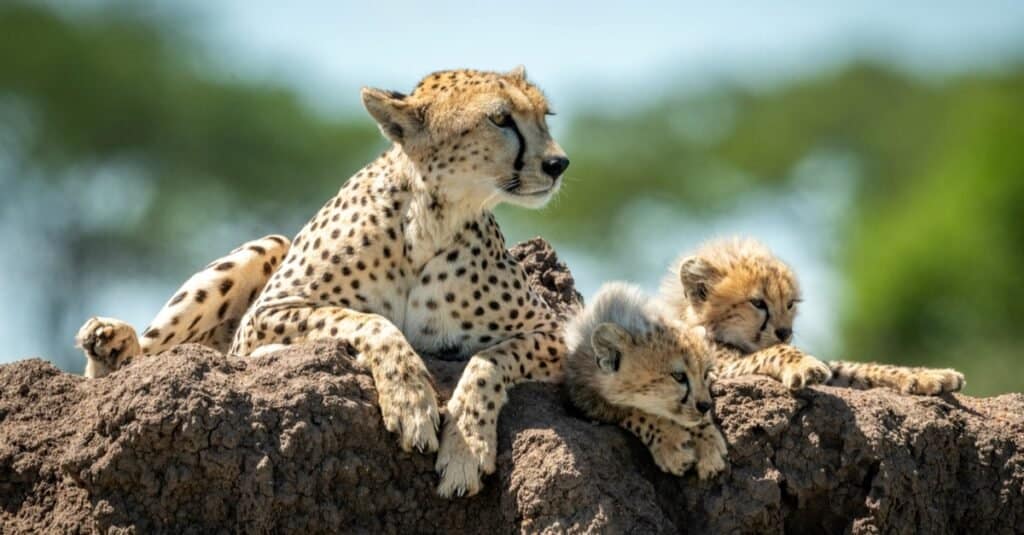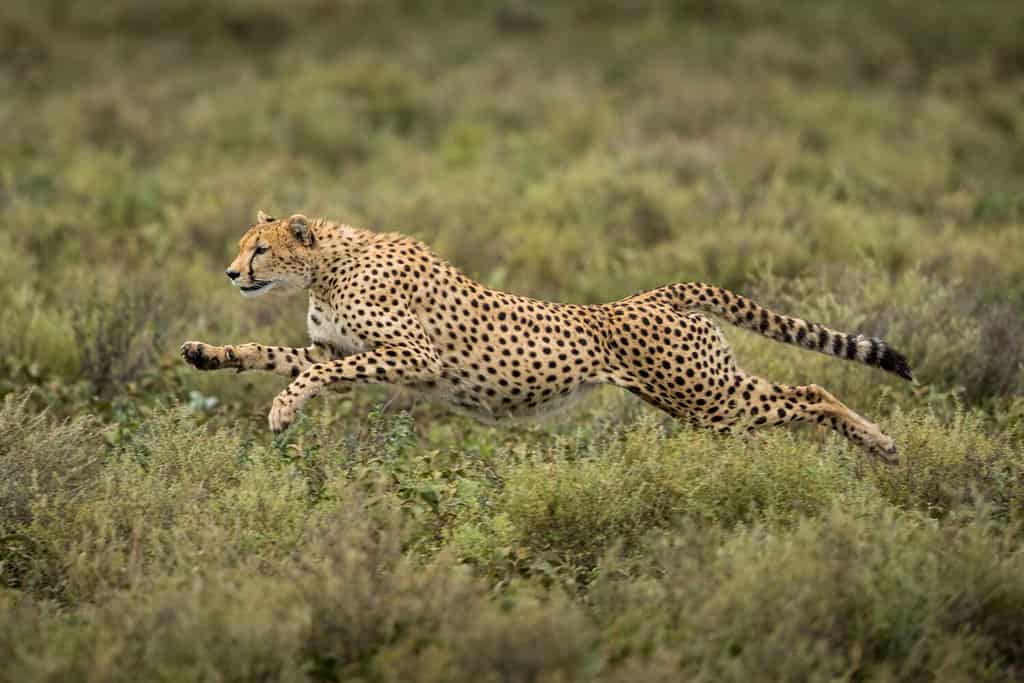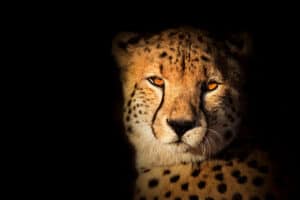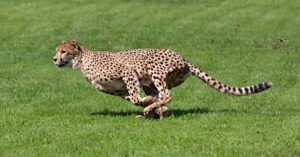A cheetah is a large feline that lives in Africa and parts of the Middle East. They are one of the fastest land animals on earth, capable of reaching speeds up to 75 mph for short distances. Cheetahs have long legs and slender bodies with a marked black “tear-stripe” running from the corner of their eyes down each side of their nose. Their fur is golden-yellow with solid black spots all over its body.
Cheetahs live mainly in open grasslands or savannas but can also be found in mountainous terrain and even desert regions. Generally, they avoid heavily populated areas due to competition with other predators. These predators include lions, hyenas and human interference, which leads to habitat loss and hunting pressure on them. Cheetahs have been listed as vulnerable by IUCN since 1996. This is due to the fact that their population has declined drastically. Human threats and genetic diversity issues lead to low numbers surviving into adulthood.
A Group of Cheetahs

Cheetahs are one of the deadliest cats, with a very fast metabolism.
©iStock.com/nicholas_dale
A group of cheetahs is called a coalition or sometimes a streak. Cheetahs have a social structure that allows them to live and hunt together in groups. Coalitions are typically made up of related males, though females may join coalitions too. A male-only coalition is known as a brotherhood, while female-only coalitions are called sisterhoods. When cheetahs come together for hunting purposes, they are often called streaks. This is because their speed and agility allow them to capture prey animals like antelopes and gazelles quickly.
How Big is The Group?
Cheetahs are usually solitary animals. Interestingly males have been living in coalitions of two to three cheetahs or even up to five. These groups are permanent, and the members form close bonds with one another. Females may join a coalition for brief periods when mating or caring for their offspring but otherwise remain solitary. Coalitions play an important role in the lives of male cheetahs. Being in a coalition helps them defend territory, hunt prey and gain access to mates.
Group Behavior

Female cheetahs tend to lead solitary lives or stay with their young in their home range.
©Stolz, Gary M., U.S. Fish and Wildlife Service, Public domain, via Wikimedia Commons – License
Cheetahs have a distinct social system that is different from most other cats. They usually keep away from one another. However, they can still be friendly. Males might fight each other to gain access to female cheetahs in estrus or to secure territory. Females usually do not interact with other individuals except when a male cheetah enters their area or during mating season. Sometimes females and their offspring or siblings will rest together during the day. Female cheetahs tend to lead solitary lives or stay with their young in their home range. In contrast, male cheetahs leave their mother’s range and live elsewhere.
Coalition Behavior
A group of cheetahs is typically referred to as a coalition. This coalition is typically made up of brothers from the same litter. However, unrelated males are also included in the coalition in some cases. Thirty percent of individuals in the coalition are unrelated males in the Serengeti plains. If a male cub is the only one in his litter, he may join up with an existing coalition. In addition, he may form a small group with only a few other lone males. Approximately 40% of male cheetahs in the Kalahari Desert live alone.
Male cheetahs that form a coalition are usually affectionate with each other and will groom one another. They will also protect each other and seek each other out if separated. Unrelated males may not be welcomed as warmly in the beginning. But, they will still have equal access to kills when the group hunts together. The advantage of being in a coalition is that they may have a better chance of mating. A study showed that solitary and grouped males have a similar chance of finding mates. It also showed that males in coalitions tend to be healthier and more likely to survive.
How Fast Are They?

Cheetahs can outrun even the fastest human athletes.
©Danita Delimont/Shutterstock.com
Cheetahs are truly impressive creatures, capable of reaching speeds of up to 64 miles per hour in just 3 seconds. This makes them the fastest land animal in the world over short distances and more than twice as fast as Usain Bolt, who holds the record for being the fastest man at 27 miles per hour. It’s amazing that cheetahs can outrun even the fastest human athlete, whether on a race track or out in the wild.
Cheetahs are known for their impressive speed, but they can only keep this up for a few minutes at most. Factors such as health, food availability, and weather or terrain conditions greatly determine how long they can sustain their top speed. Despite having an incredibly stable body temperature even when running after prey, cheetahs may still choose to give up on the hunt if it becomes too strenuous for them. This is why it’s not uncommon to see them taking breaks throughout their pursuit of prey in order to conserve energy and stay healthy.
Group of Cheetahs: What Do They Hunt?
Cheetahs typically hunt a variety of small to mid-sized animals, such as kob, impalas, gazelle, duiker, and springbok. Additionally, they can also target ground-nesting birds and small creatures such as rabbits. Male cheetahs have been observed to team up in order to guard their territory and bring down much bigger animals, including eland, kudu, and wildebeest.
Cheetahs are not scavengers and prefer freshly killed prey. They gulp down their food quickly because many other competing species will steal it if they don’t. Around ten percent of their dinners get stolen, so they have started hunting during daylight when other predators sleep.
Who Hunts Them?

Human beings are the biggest threat to the survival of cheetahs.
©Stu Porter/Shutterstock.com
Other animals do not usually hunt a cheetah, but predators such as hungry lions eat a large percentage of cheetah cubs. The mortality rate of cheetah babies is very high, and most of them do not reach maturity. Furthermore, the food that cheetahs hunt is often taken away by lions, hyenas, leopards, wild dogs, and vultures, so starvation is a problem. Cheetahs typically live between 10 and 12 years in the wild but can live up to 20 years in captivity.
Human beings are the biggest threat to the survival of cheetahs. They hunt them for their fur and sometimes even kill them in order to protect livestock or other domestic animals. In addition, habitat destruction due to human activities has decreased prey species available for cheetahs, making it more difficult for them to survive. The spread of human habitats and increased land usage for farming means that the available land for cheetahs is sharply declining.
Population
Cheetahs once roamed freely throughout large parts of Africa and the Arabian Peninsula, but their numbers have plummeted over the years. Their habitats are now confined to only a small fraction (10%) of what they once were. Cheetahs can mainly be found in select areas of Southern and Eastern Africa. In Asia, wild cheetah populations have been drastically reduced, with estimates indicating that there may be as few as 12 individuals left in the region.
These remaining cheetah populations are located solely within the deserts of Iran and face several threats from human activity, such as habitat loss, prey depletion due to hunting activities, the conflict between humans and wildlife caused by competition for resources, and infrastructure development which further encroaches on their living spaces. It is important that conservation measures continue to protect these endangered animals, or else they may face complete extinction from these regions in the near future.
The photo featured at the top of this post is © Stu Porter/Shutterstock.com
Thank you for reading! Have some feedback for us? Contact the AZ Animals editorial team.






